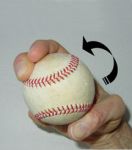

Two seam fastball
A two seam fastball, much like a sinker or cutter (cut fastball), is gripped slightly tighter and deeper in the throwing-hand than the four-seam fastball. This pitch generally is thought of as a "movement pitch" (as opposed to the four-seam fastball, which is primarily thought of as a "straight pitch").
When throwing a two-seam fastball, your index and middle fingers are placed directly on top of the narrow seams of the baseball (as shown in the picture on the left).
Next, place your thumb directly on the bottom side of the baseball and on the smooth leather in between the narrow seams (as shown in the picture on the right).
Again, a two seamer is gripped a little firmer than the four seamer. A firm grip causes friction, which causes the baseball to change direction, usually "backing up" - or running in - to the throwing hand side of the plate. It also slightly reduces the speed of the pitch, which is why most two-seamers register about 1 to 3 mph slower than four-seam fastballs.

Circle changeup
The circle changeup and the four-seam fastball are what got me to professional baseball. They're both great pitches.
To throw a circle changeup make - quite literally - a circle or an "OK" gesture with your throwing hand (using your thumb and index fingers). You then center the baseball between your three other fingers (as shown in the middle picture above right). The baseball should be tucked comfortably against the circle.
Throw this pitch with the same arm speed and body mechanics as a fastball, only slightly turn the ball over by throwing the circle to the target. This is called pronating your hand. (Think about this as giving someone standing directly in front of you a "thumbs down" sign with your throwing hand.) This reduces speed and gives you that nice, fading movement to your throwing-arm side of the plate.

Beginner's curveball
The beginners curveball is a great pitch for younger pitchers. In essence, this pitch does the exact opposite as a fastball. Where as a fastball spins from the bottom to top (which is known as "backspin"), a curveball spins from top to bottom. And instead of leverage coming from behind the top of the baseball (as a four-seam fastball), leverage on a curve comes from the front of the baseball.Click here for more info on changeups.
I teach a beginners curveball grip to younger pitchers who are learning a curveball for the first time because I feel that it's the easiest way to correctly learn proper spin. (But I also think this is a great grip for more advanced pitchers to use in a practice setting if you're having trouble with your breaking ball.)
Here's how it works: Grip a baseball leaving the index finger off — like you were pointing at something. (Your index finger will be used to aim the baseball at your target.)
Next, place your middle finger along the bottom seam of the baseball and place your thumb on the back seam (as shown in the middle picture above). When this pitch is thrown, your thumb should rotate upward, and your middle finger should snap downward while your index finger points in the direction of your target. This, of course, is the reason this pitch is great for beginners: the ball goes where your index finger points. The beginners curveball helps to align your hand and ball to the target. Click here for more info on techniques.
Note: Because hitters at the college and professional levels may be able to pick up on the "raised" finger during this pitch's delivery, a beginners curve shouldn't be used past high school ball.

home
New Pitching Techniques
Team Schedule
Hitting Drills